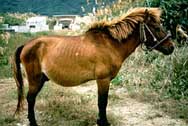Yonaguni
N/A
Fri, 11th April, 2025 - 11:03 pm GMT
Sponsor Ads:

Alternative Name
N/ABasic Info
The breed is small, standing about 11 hands (115 cm). Two small herds of about 108 horses remain on the island ranging free and are rounded up once a year for inspection, removal of pests and inoculation. The Yonaguni are usually chestnut. The head is large with well-placed eyes and relatively small ears; the neck is short and thick; the shoulders tend to be straight; the back is long; the croup is often quite level with a high tail-set; the quarters are slight; the legs often tend to be splayed; the hooves are vertically long and very hard.
Health
N/AHabitat
landBehavior
N/AOrigin
JapanHistory
The Yonaguni is a small native pony of the southwest islands of Japan. In 1996 there were about seventy-five living Yonaguni ponies on East and North Ranches on Yonaguni Island, located on the west side of the Yaeyama Islands. Little is known about the origin of the Yonaguni. Horses in Japan can generally be divided into two groups, larger specimens from Hokkaido and smaller individuals from Yonaguni. Many people believe that the small horses were introduced from the southern islands during the Jyomon Period, about two thousand years ago. Professor Ken Nozawa of Kyoto University claimed in 1983 that the gene characteristcs of the breed indicated relationship to the Cheju breed in Korea.Common Foods
grassSponsor Ads:
"When you plunder a countryside, let the spoil be divided amongst your men; when you capture new territory, cut it up into allotments for the benefit of the soldiery." -- Sun Tzu, The Art of War
Yonaguni
Coded by: BGID® | ALL RIGHTS RESERVED Copyright © 2000-2025
Disclaimer | Privacy | Report Errors / Contact | Credits


 Preparing For China. China is growing their military. China Military Technology - can it keep up with the US?
Preparing For China. China is growing their military. China Military Technology - can it keep up with the US?  versus
versus 

 versus
versus 
 This Thread is about the North Korean Military itself - the kind of army, navy, and air force they have.
This Thread is about the North Korean Military itself - the kind of army, navy, and air force they have. 
 versus
versus 
 versus
versus  versus
versus